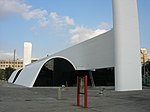Estádio Palestra Itália

The Palestra Itália Stadium (Portuguese: Estádio Palestra Itália), was a football stadium located in Barra Funda, São Paulo, standing on the site now occupied by the Allianz Parque stadium. It was the home ground of Sociedade Esportiva Palmeiras from 1917 to 2010, and was also known as Parque Antártica after Companhia Antarctica de Bebidas, a beverages company from which Palmeiras acquired the property in 1920. In the past its capacity was listed as 35,000 spectators, however, even though its grandstands have been extended in the late 1990s, the stadium had 27,650 seats due to regulations enforcing improved safety and comfort, before was demolished in November 2010. It was one of the most important Brazilian stadiums, considering the amount of decisive and important matches played there, most of them with the presence of Palmeiras. Examples of games played in Palestra Itália include the second leg of the 1999 Copa Libertadores Finals, the Copa Mercosur finals of 1998, 1999 and 2000, 1996 Copa do Brasil final and several Campeonato Paulista finals. One of the 2000 Campeonato Brasileiro Série A final matches, between São Caetano and Vasco was played at Palestra Itália. One of the 2004 Copa do Brasil final matches, between Santo André and Flamengo was played there too. Besides football matches, the Palestra Itália Stadium, often hosted important Brazilian and international musical events because of its central location in São Paulo, like A-ha, Human Rights Now!, Ozzy Osbourne, Iron Maiden, Metallica, Aerosmith, David Bowie and Guns N' Roses. On May 22, 2010, Palmeiras played against Grêmio for the Série A on Palestra Itália, it was the last official game played by Palmeiras in the stadium due to the beginning of the new stadium's construction. The last match played by Palmeiras on Palestra Italia was a friendly against Boca Juniors on July 9, 2010.
Excerpt from the Wikipedia article Estádio Palestra Itália (License: CC BY-SA 3.0, Authors, Images).Estádio Palestra Itália
Rua Palestra Itália, São Paulo Barra Funda (Perdizes)
Geographical coordinates (GPS) Address Phone number Website Nearby Places Show on map
Geographical coordinates (GPS)
| Latitude | Longitude |
|---|---|
| N -23.527555555556 ° | E -46.678416666667 ° |
Address
Allianz Parque (Arena do Palmeiras)
Rua Palestra Itália 1840
05005-000 São Paulo, Barra Funda (Perdizes)
São Paulo, Brazil
Open on Google Maps









